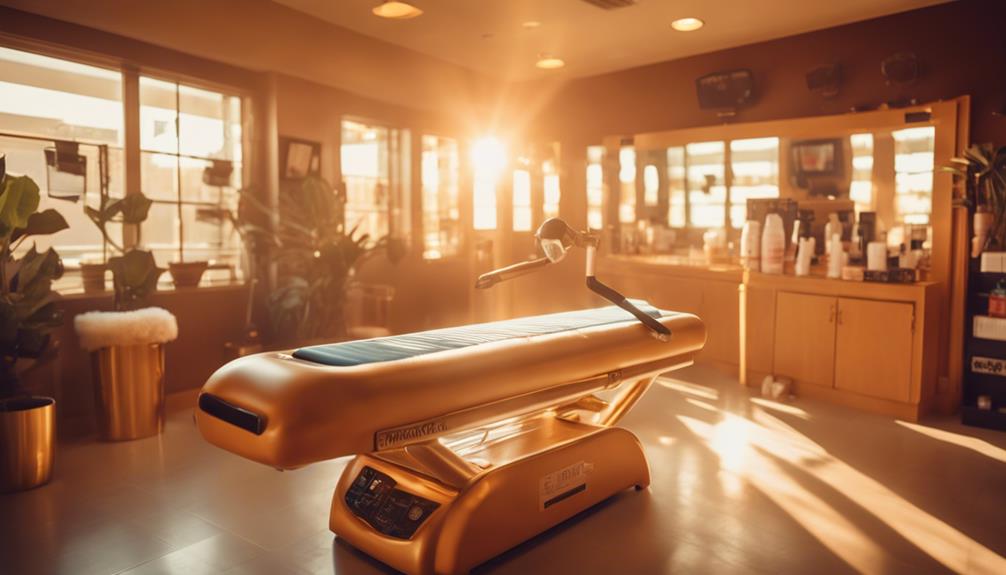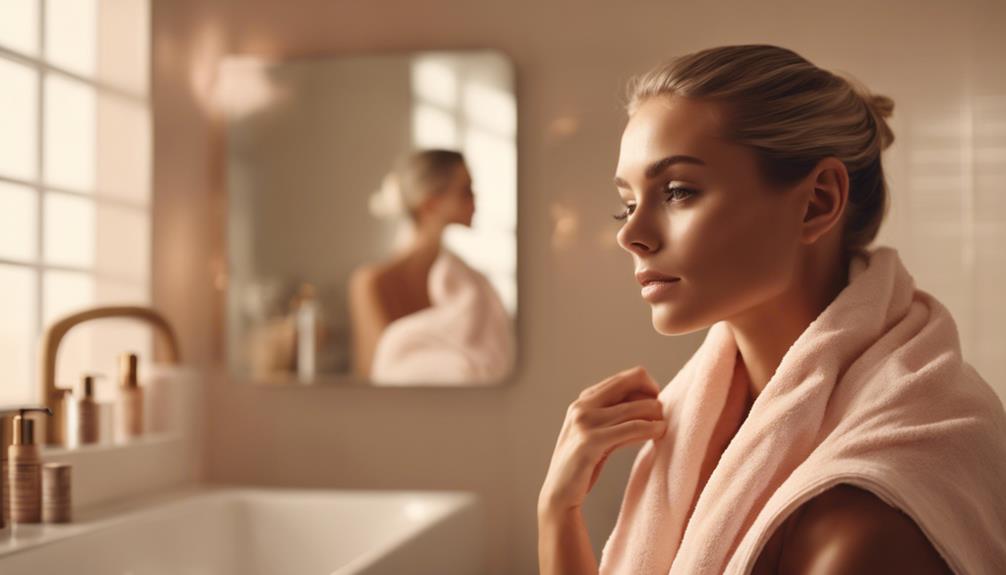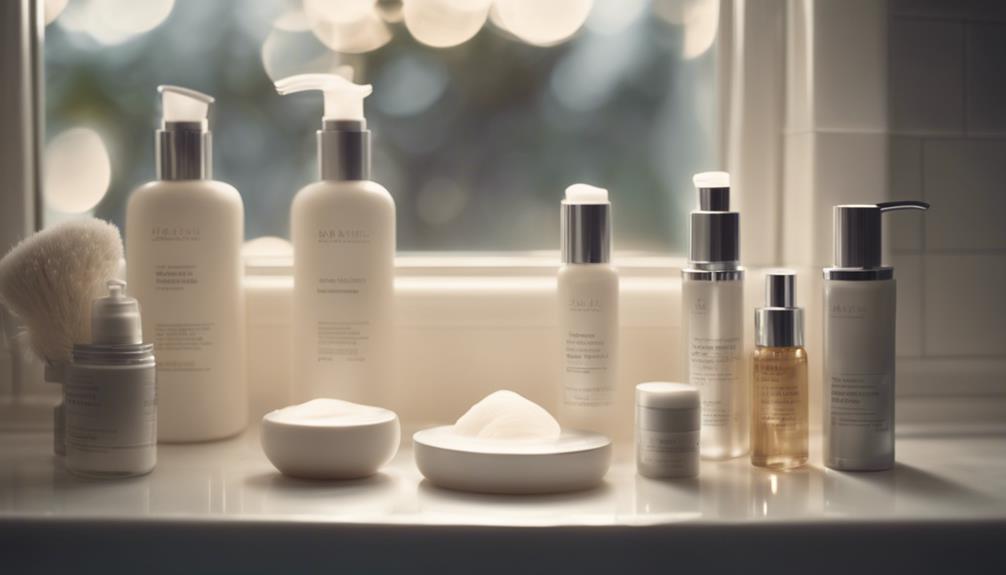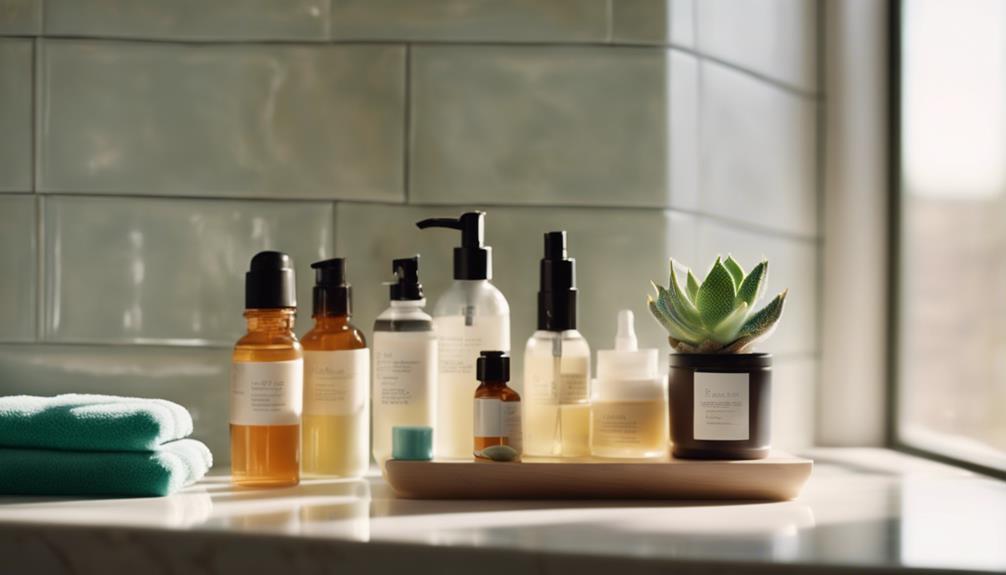Tanning beds can offer a fun way to achieve a sun-kissed appearance, but safety should always be the top priority. Before getting started, it’s important to determine your skin type – fair skin is more prone to burning, so it’s best to start with short sessions. Prepping your skin by exfoliating the day before can help ensure a smooth tan, and using a non-oily lotion is essential. Don’t forget to protect your eyes with goggles! Start with brief sessions, typically 4-6 minutes, and gradually increase the time based on how your skin reacts. Staying hydrated is crucial, so remember to drink plenty of water after tanning. Looking to prolong that glow? Stay tuned for some expert tips!
Key Takeaways
- Always wear protective goggles to shield your eyes from harmful UV rays during tanning sessions.
- Start with shorter tanning sessions, especially if you're a beginner, to avoid skin burns.
- Exfoliate and moisturize your skin prior to tanning for an even and healthy tan.
- Gradually increase your tanning time while monitoring your skin's reaction for discomfort.
Skin Type Assessment
To achieve a safe and effective tan, you first need to assess your skin type, which helps you understand how your skin reacts to UV exposure.
Think of your skin as a canvas; pale skin might burn quicker than a pizza left in the oven too long, while olive or caramel tones might tan like a sun-kissed cookie.
It's important to check any medications you're on, too, since some can make your skin more sensitive to UV rays—like how some kids can't handle spicy food!
Knowing your skin type isn't just smart; it's essential for a safe tanning experience.
Pre-Tan Preparation
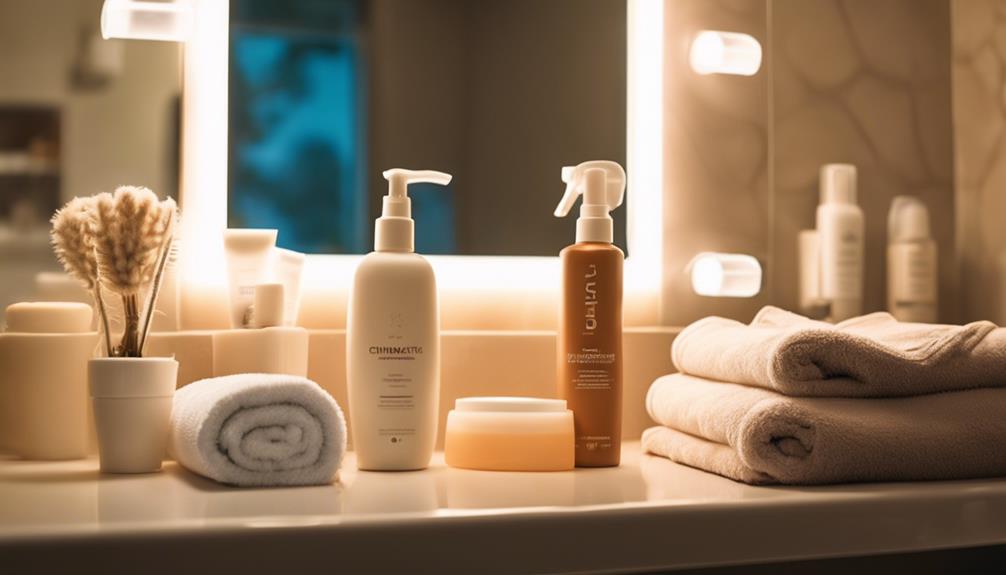
Getting your skin ready for tanning is essential, so make sure to exfoliate at least a day in advance for an even glow. Think of your skin like a canvas; the smoother it is, the better your tan will be!
After exfoliating, shower and shave to remove any pesky hairs that could block that beautiful bronzed color. Don't forget to apply a light, non-oil-based moisturizer to keep your skin hydrated.
Before you hit the tanning bed, skip the makeup, jewelry, and strong scents—your skin will thank you! And if you're using indoor tanning lotion, spread it evenly for the best results.
Choosing Tanning Beds

Selecting the right tanning bed is essential for achieving your desired results while ensuring your skin's safety and health.
You wouldn't wear shoes that are two sizes too small, right? The same goes for tanning beds!
Consult salon experts to find a bed that suits your skin type. You can choose between traditional horizontal beds and stand-up booths, each offering different UV exposure levels.
If you have fair skin, you might want to start with a gentler option, while those with darker skin tones may prefer a stronger bed.
Remember, it's all about finding what works for you! So, don't hesitate to ask questions and get advice tailored to your unique skin needs.
Happy tanning!
Safe Usage Practices
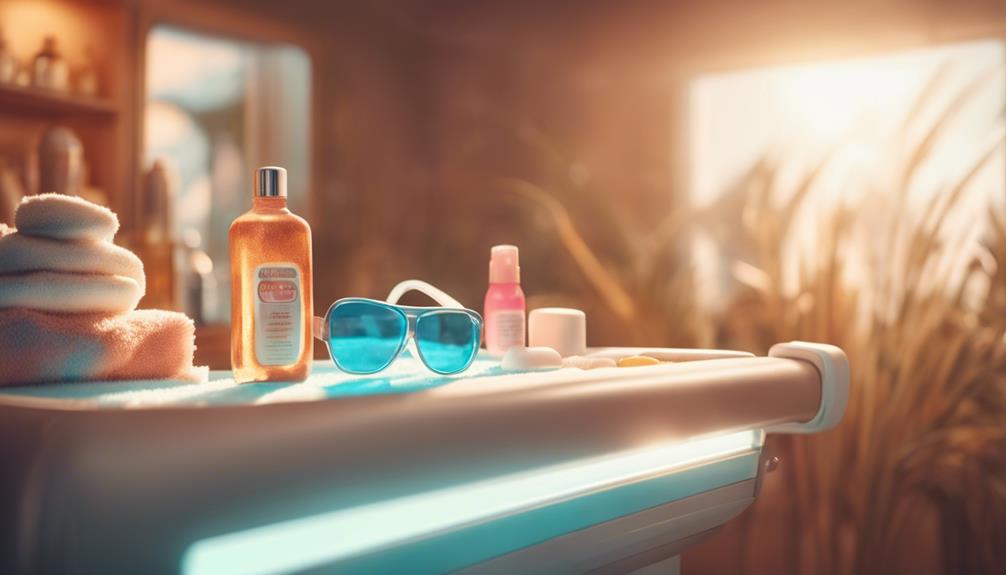
Using tanning beds safely requires you to follow specific guidelines that guarantee both effective tanning and skin protection. Think of tanning like cooking a perfect meal—you need the right ingredients and timing! Some essential tanning bed safety tips include wearing eye protection to protect your eyes from the UV rays, using a timer to regulate your tanning session, and consulting with a dermatologist to determine the appropriate tanning schedule for your skin type. By following these guidelines, you can achieve a safe and healthy tan without compromising the health of your skin. Remember, just like cooking, tanning requires careful attention to detail and proper technique to achieve the best results. Additionally, moisturizing your skin before and after a session is crucial to prevent dryness and maintain a healthy glow. It’s also important to start with shorter sessions, gradually building up time to avoid overexposure and reduce the risk of burns. By adhering to these tanning bed safety tips, you can enjoy your desired tan while minimizing potential skin damage and promoting long-term skin health.
Here are three key practices to keep in mind:
- Start with shorter sessions, especially if you're new to tanning or have fair skin.
- Gradually increase your exposure time to avoid sunburn—nobody wants that!
- Always listen to your skin; if it starts feeling uncomfortable, it's time to stop.
Protective Gear Importance
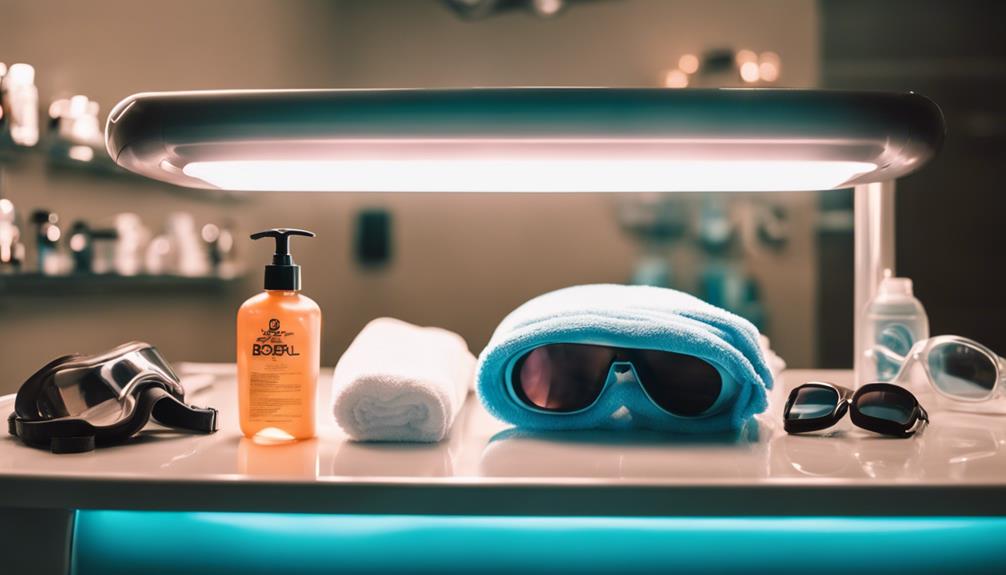
Protective gear plays an essential role in guaranteeing your tanning experience is both safe and effective. Imagine going to the beach without sunscreen—yikes, right? That's how important protective gear is!
When you step into a tanning bed, always wear goggles to shield your eyes from harmful UV rays. It's like wearing sunglasses on a sunny day!
You might also want to wear a bathing suit or some coverage, because your skin deserves protection, too. Quality goggles are an investment, so check them regularly to verify they're in good shape.
Post-Tan Care
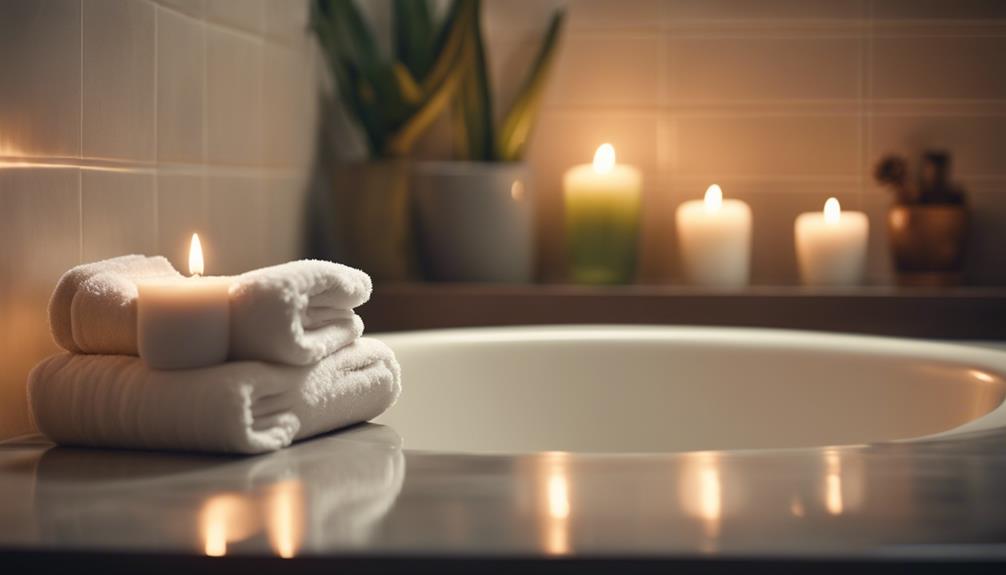
Moisturizing your skin immediately after tanning is essential for locking in your color and preventing dryness.
Think of it like watering a plant after a sunny day; it helps keep everything vibrant!
Here are three key post-tan care tips to follow:
- Use a Good Moisturizer: Choose a lotion that's rich and hydrating to keep your skin soft and your tan glowing.
- Skip the Shower for a While: Allow your tan to set before jumping in the shower; wait at least a few hours to avoid rinsing it away.
- Stay Hydrated: Drink plenty of water! It's like giving your skin a rejuvenating drink from the inside out.
Following these tips guarantees your tan lasts longer and looks fabulous!
Tips for Beginners
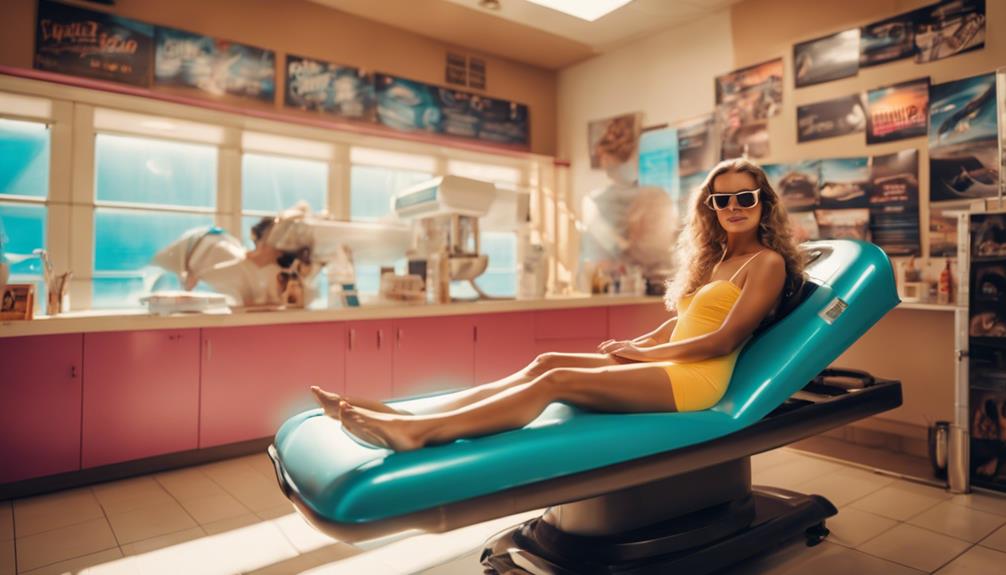
Before stepping into a tanning bed, it's crucial to understand your skin type and start with shorter sessions to avoid burns.
Think of your skin as a delicate flower; you wouldn't throw it in the sun all day, right? Start with about 4-6 minutes for your first session, and pay attention to how your skin reacts. If it feels like it's getting too hot, listen to it!
Gradually add a minute or two each time, but don't rush the process. Always wear those funky goggles—your eyes need protection too!
And remember, a little prep goes a long way; exfoliate and moisturize before tanning.
With care and patience, you'll be on your way to a gorgeous glow!
Frequently Asked Questions
Can I Tan if I Have a Sunburn?
You shouldn't tan with a sunburn. Your skin's already compromised, increasing the risk of pain and peeling. Focus on healing first, then gradually reintroduce tanning once your skin's back to normal.
How Often Can I Use a Tanning Bed?
Using a tanning bed is like watering a plant; too much can drown it. You shouldn't tan more than twice a week. Listen to your skin's needs and adjust your sessions accordingly for ideal results.
Are Tanning Beds Safe for Pregnant Women?
Tanning beds aren't generally recommended for pregnant women due to increased skin sensitivity and potential risks to your baby. It's best to consult your healthcare provider before considering any tanning options during pregnancy.
Do Tanning Beds Cause Skin Cancer?
Yes, tanning beds can increase your risk of skin cancer. They emit UV radiation, which damages skin cells. It's essential you understand these risks and take preventive measures if you decide to use them.
Can I Use Tanning Beds During My Menstrual Cycle?
Yes, you can use tanning beds during your menstrual cycle. Just make certain you're comfortable and listen to your body. Stay hydrated and follow safety protocols for the best experience while tanning. Enjoy your session!
Conclusion
So, as you gear up for your tanning adventure, remember: safety first!
You've got the essential tips to help you glow without the burn.
Picture yourself stepping into that tanning bed, excitement bubbling inside, but wait—will you choose the right exposure time?
Will you use protective gear? The answers are just a session away!
Embrace the process, enjoy your sun-kissed journey, and who knows, you might just end up with a radiant tan that makes everyone say, “Wow!”
